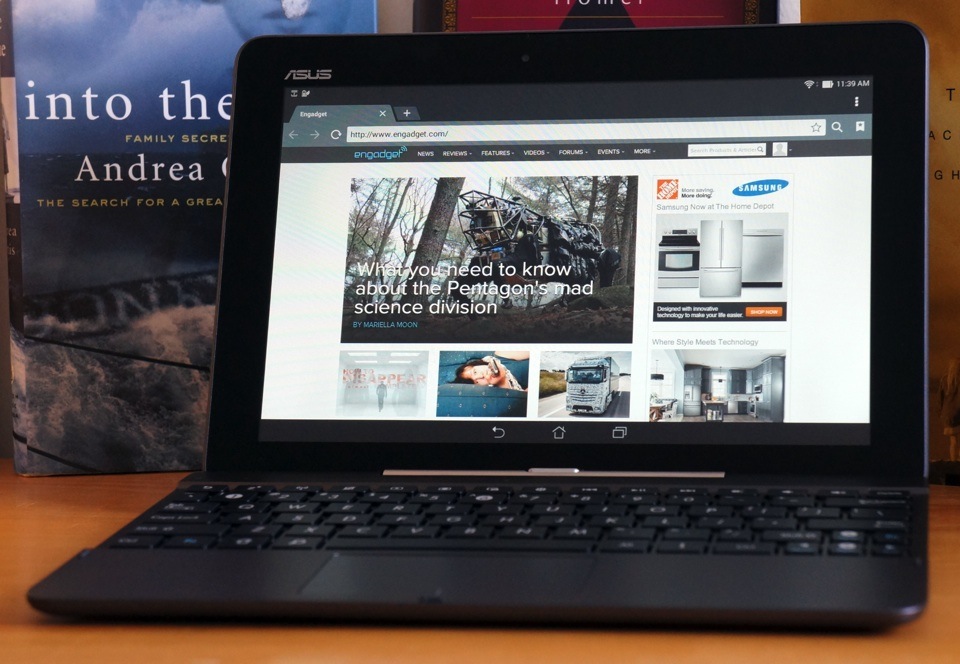
When it comes to ASUS, buying a full-size Android tablet has usually meant venturing past the $300 mark; even the Transformer Book T100 set you back $349 when it first came out, and that was considered a steal. That's no longer a problem in 2014. ASUS' new Transformer Pad TF103C costs $299 with the company's signature keyboard dock included, or as much as some smaller mid-range slates. While that's potentially a hefty bargain, it begs a few questions: Just what are you giving up to get that price? And is it worth the trade-off when you could likely snag a smaller, but more powerful tablet for less? As I've learned, you're making quite a few sacrifices in the name of a better deal. This is still quality hardware, but you have to know what you're in for.
74
ASUS
Transformer Pad TF103C
Pros
- Great value
- Fast for the money
- Comfortable typing experience
Cons
- Terrible cameras
- Low-resolution display
- So-so battery life
Summary
ASUS' entry-level Transformer Pad sacrifices quite a bit in the
name of price, but you still get a speedy, well-designed Android tablet
that can serve as a basic laptop in a pinch.
Don't expect a revolution on the outside. Aside from the smooth matte finish on the non-removable back and some cosmetic tweaks to the speaker grilles, the TF103C will seem awfully familiar if you've used a Transformer-series tablet like the T100. Not that I'm grousing much about it. That still makes for a comfortable grip, and the tablet alone is light for its size at 1.2 pounds -- not as svelte as the 1.07-pound Galaxy Tab 4 10.1, but on par with LG's similarly sized G Pad. About the only step backward is the overly smudge-prone casing on the black model. You'll want to track down the white variant if you insist on keeping the case looking pristine.
Of course, that also means the same drawbacks have returned. The tablet's 16:10 aspect ratio is fine for landscape viewing -- arguably where you'll spend most of your time -- but not so hot for reading books in portrait mode. Moreover, the combination of dock and tablet is relatively thick (0.78 inch) and heavy (2.43 pounds) considering the energy-efficient technology you're getting. I'm not expecting something wafer-thin, but it would be nice if the TF103C were easier to tote around than far more powerful devices like the 11-inch MacBook Air or Surface Pro 3, you know?
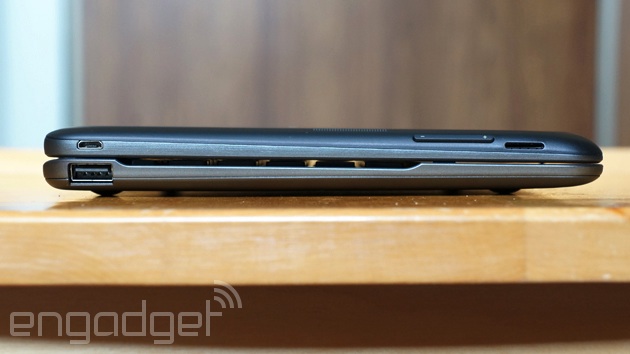 A closer inspection reveals a few of the more conspicuous reasons why
this Transformer Pad is so cheap. You'll once more find a microSD
storage slot, a micro-USB port and the volume rocker within easy reach
on the left side. However, ASUS has yanked the micro-HDMI video output
seen on other tablets -- you'll have to make do with streaming
technology like Miracast if you want to put movies on your TV. You will
find a 2-megapixel rear camera where there was no such cam at all on the
T100, but the front camera is a basic 0.3-megapixel unit that rules out
any HD video chats. There's also a single USB 2.0 port on the dock
instead of the T100's USB 3.0, although that isn't a big deal when
Android doesn't make much use of the faster connection standard.
A closer inspection reveals a few of the more conspicuous reasons why
this Transformer Pad is so cheap. You'll once more find a microSD
storage slot, a micro-USB port and the volume rocker within easy reach
on the left side. However, ASUS has yanked the micro-HDMI video output
seen on other tablets -- you'll have to make do with streaming
technology like Miracast if you want to put movies on your TV. You will
find a 2-megapixel rear camera where there was no such cam at all on the
T100, but the front camera is a basic 0.3-megapixel unit that rules out
any HD video chats. There's also a single USB 2.0 port on the dock
instead of the T100's USB 3.0, although that isn't a big deal when
Android doesn't make much use of the faster connection standard.
You won't find a lot of future-proofing inside, either. The starter Transformer ships with ordinary 802.11n WiFi and Bluetooth 4.0 for wireless, and my test unit carries a modest 16GB of built-in storage. There's an 8GB version, too, but you're not likely to find it in the US. That's just as well, since you'd run out of space very quickly with that model; even my device had just 10.3GB free before I started piling on the apps. You will find built-in GPS and GLONASS positioning, though, so you won't need to splurge on a cellular-ready tablet just to navigate through an unfamiliar city.
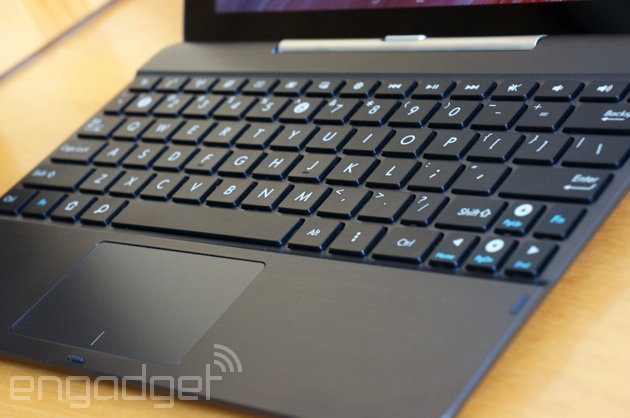 As always, the keyboard dock is why you're looking at a Transformer
tablet in the first place. That's especially true for the TF103C, which
has very little keyboard-equipped competition in its price range.
Thankfully, ASUS hasn't skimped on the quality just to get that $299
sticker. This is the T100's dock rejiggered for Android, and that's
mostly a good thing. Although the keys are too small for me to type at a
breakneck pace, the keyboard as a whole is supremely helpful for
drafting long emails and controlling basic settings like brightness. The
touchpad, meanwhile, is a slight refinement over the T100; it has the
same tiny surface and hidden buttons, but none of the jumpiness. Android
admittedly doesn't make nearly as much use of mouse input as Windows
does, but the pad is convenient for quickly selecting text or other
moments when you don't want to lift your hands.
As always, the keyboard dock is why you're looking at a Transformer
tablet in the first place. That's especially true for the TF103C, which
has very little keyboard-equipped competition in its price range.
Thankfully, ASUS hasn't skimped on the quality just to get that $299
sticker. This is the T100's dock rejiggered for Android, and that's
mostly a good thing. Although the keys are too small for me to type at a
breakneck pace, the keyboard as a whole is supremely helpful for
drafting long emails and controlling basic settings like brightness. The
touchpad, meanwhile, is a slight refinement over the T100; it has the
same tiny surface and hidden buttons, but none of the jumpiness. Android
admittedly doesn't make nearly as much use of mouse input as Windows
does, but the pad is convenient for quickly selecting text or other
moments when you don't want to lift your hands.
Having said that, all the quirks from recent ASUS docks remain intact. The buttons are a bit noisy, and some of them (especially the arrows and function key) are too tiny to find by feel alone. It also took some time to get used to the inherently top-heavy nature of the docked combo. Mind you, that's partly due to what's missing in the dock this time around -- a secondary battery. While you won't find one in the higher-end TF303CL or many other dockable tablets, the absence is disappointing given that earlier Transformers often made use of a spare cell.
 If the dock is why the TF103C's price is so alluring, the screen is a
big reason why the tablet costs so little in the first place. A
10.1-inch, 1,280 x 800 display is no great shakes in an era when 1080p
or higher is quite common, even on small hardware like the G Pad 8.3 or Nexus 7.
The low pixel density (149 ppi, to be exact) isn't terrible, but it was
noticeable whenever I was reading or playing a visually intensive game.
At least the overall picture quality holds up. The IPS-based LCD
produces rich colors, shines brightly at 400 nits and only loses a
moderate amount of that brightness when viewed from sharp angles. If all
you're looking for is a reasonably true-to-life image, you'll be happy
with what this Transformer has to offer.
If the dock is why the TF103C's price is so alluring, the screen is a
big reason why the tablet costs so little in the first place. A
10.1-inch, 1,280 x 800 display is no great shakes in an era when 1080p
or higher is quite common, even on small hardware like the G Pad 8.3 or Nexus 7.
The low pixel density (149 ppi, to be exact) isn't terrible, but it was
noticeable whenever I was reading or playing a visually intensive game.
At least the overall picture quality holds up. The IPS-based LCD
produces rich colors, shines brightly at 400 nits and only loses a
moderate amount of that brightness when viewed from sharp angles. If all
you're looking for is a reasonably true-to-life image, you'll be happy
with what this Transformer has to offer.
Audio is another story. The two rear-firing speakers are barely loud enough for a quiet environment, even if you cup your hands around the speakers to direct the sound forward. Bass is equally weak -- playing dance music will leave you without the satisfying punch you get on the G Pad 8.3 or recent iPads. While the output is clear, I just couldn't get engrossed in movie dialogue or music without plugging in some headphones. Should you want a mobile media center, you're better off giving up the TF103C's screen real estate to get something with a fuller sound and a sharper picture.
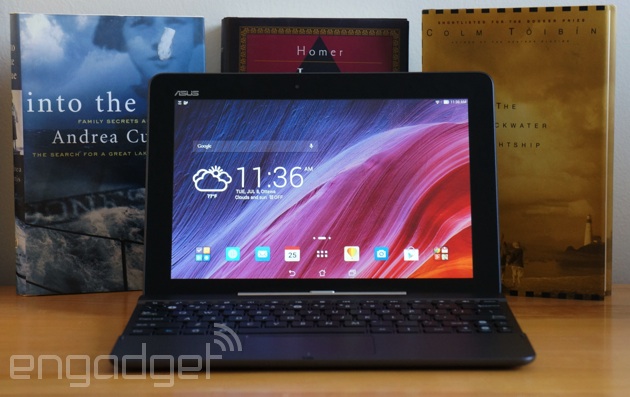 If you've tried the Padfone X
or other ASUS devices circa 2014, you'll have a good sense of what to
expect from the Transformer Pad's ZenUI interface -- minus the phone
part, of course. The company has given Android 4.4.2 KitKat just enough
of a makeover to make it distinctive, with trendy "flat" (read:
textureless) icons and bright colors. It's otherwise a very hands-off
approach, though. While you'll see useful upgrades like quick access to
settings and more polished media galleries, aspects like multitasking
have largely gone untouched. I won't deny missing out on some advanced
features that require more customization, like Samsung's multi-window
support. Nonetheless, there's a certain refreshing simplicity to ZenUI.
It's easy to find your way around, and it's blissfully free of
unnecessary effects and transitions that might slow you down.
If you've tried the Padfone X
or other ASUS devices circa 2014, you'll have a good sense of what to
expect from the Transformer Pad's ZenUI interface -- minus the phone
part, of course. The company has given Android 4.4.2 KitKat just enough
of a makeover to make it distinctive, with trendy "flat" (read:
textureless) icons and bright colors. It's otherwise a very hands-off
approach, though. While you'll see useful upgrades like quick access to
settings and more polished media galleries, aspects like multitasking
have largely gone untouched. I won't deny missing out on some advanced
features that require more customization, like Samsung's multi-window
support. Nonetheless, there's a certain refreshing simplicity to ZenUI.
It's easy to find your way around, and it's blissfully free of
unnecessary effects and transitions that might slow you down.
ASUS doesn't go overboard with preloaded apps, for that matter. Most of what you'll see are lightweight utilities that fill in a few gaps in Android's stock interface, like Splendid (display calibration) and Do It Later (to-do lists). Some are deeper, if not always useful. I most appreciated SuperNote, which lets you jot down a mix of typed and drawn notes; Story, on the other hand, is the classic diary app that you try once and quickly forget. I found the third-party software more practical. You'll have Flipboard, Kindle and Zinio apps for reading, while eMusic gives you another means of downloading tunes beyond Google Play.
Intel-based Android tablets like the TF103C are nothing new, even if
they're still rare. However, the quad-core, 1.33GHz Atom Z3745 processor
found here is very much up to the job of powering Google's mobile
platform. If anything, this budget hardware regularly punches above its
weight class. It's typically speedier in benchmarks than an Exynos 5
Octa-based tablet like the Galaxy Tab S, and it's not all that far off from Snapdragon 800 devices like ASUS' own Padfone X.
That's borne out by the real-world performance. I've already touched on the zippy interface, but the Transformer Pad doesn't act like an econo-slab when running apps, either. Web pages pop up quickly, and even a graphics-heavy 3D game like Real Racing 3 runs smoothly regardless of what's on the screen. To some extent, the lower-resolution display helps keep things quick; there aren't as many pixels to push around, after all. Even so, it's apparent that this Transformer Pad has more muscle than you'd expect, and our offscreen graphics test (GFXBench) shows that it wouldn't be a slouch with a 1080p display.
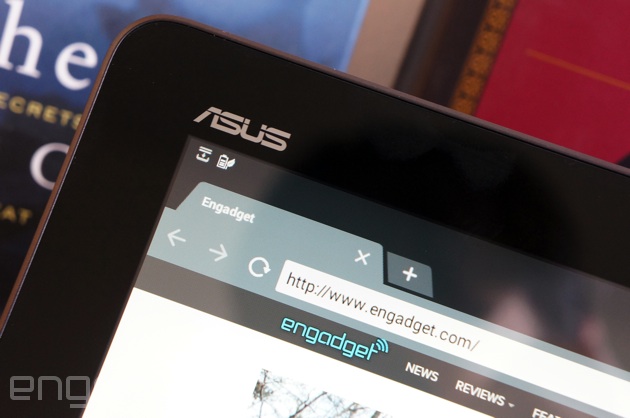 Just don't plan on juggling many apps at the same time. While the
TF103C's 1GB of RAM was generally adequate, there were a couple of
moments when it balked; even after purging the device's memory, I
couldn't run one benchmark until I'd rebooted. I wouldn't say that's a
dealbreaker for Android gear this cheap, but it does make me worry about
software performance in the long run, when operating system upgrades
and next-generation 3D games put some extra strain on the memory. If I
were running the show, I would have kept the T100's 2GB of RAM just to
guarantee a hiccup-free experience.
Just don't plan on juggling many apps at the same time. While the
TF103C's 1GB of RAM was generally adequate, there were a couple of
moments when it balked; even after purging the device's memory, I
couldn't run one benchmark until I'd rebooted. I wouldn't say that's a
dealbreaker for Android gear this cheap, but it does make me worry about
software performance in the long run, when operating system upgrades
and next-generation 3D games put some extra strain on the memory. If I
were running the show, I would have kept the T100's 2GB of RAM just to
guarantee a hiccup-free experience.
Keeping the 11-hour battery life would have been nice, too. The Transformer Pad's 19-watt-hour lithium cell is officially rated for a less ambitious 9.5 hours when playing non-stop 720p video, and that's assuming you both keep the screen relatively dim (100 nits) and avoid social networks. In Engadget-grade stress testing, which upped the brightness to the halfway mark (200 nits) and allowed for updates from Facebook and Twitter, the tablet conked out after eight hours and 26 minutes. That's not terrible by any stretch, but it's a far cry from the 10-plus hours of the T100, the Galaxy Tab S and most iPads.
Most people don't watch that much video, though, and the good news is
that you won't have trouble getting through a full day of less
demanding uses that include web browsing, social networking and small
bursts of gaming. If you need to go further, there's also a special
energy mode that will drop the internet connection when you leave the
device idle. No, that's not really practical in most circumstances, but
it might save your hide if you need to check your email after a long
trip.

You might have gathered that the TF103C wouldn't be a photography champ from the specs... and you'd be right. The 2-megapixel rear camera isn't the worst I've seen on a device -- that dubious honor belongs to the ZTE Open -- but it produces drab-looking photos and videos even in good lighting. Low detail, blown-out highlights and lots of noise are commonplace. In darker conditions, the results are downright ugly. Meanwhile, the front 0.3-megapixel camera is only properly useful for video conversations. It's slightly ironic that the shooting interface includes a full range of filters and settings (including ISO and white balance), since you're rarely, if ever, going to get a masterpiece. Really, the cameras are more utilitarian than anything. They're here to make sure you can capture a whiteboard or say hello on Skype, and not much else.
 It's tempting to argue that there isn't any real competition for the
TF103C, at least not in the most literal sense. How many budget 10-inch
Android tablets come with their own keyboard docks? There is one obvious
parallel, however: Archos' 101 XS 2.
Mind you, it's not much of a contest. The XS 2 does ship with a
healthier 2GB of RAM, but its quad-core, 1.6GHz Rockchip processor isn't
even in the same ballpark as the Atom in the Transformer Pad. It's also
not as elegant, since you can't just fold things shut when you're done;
you have to detach the keyboard cover every time you're ready to pack
up. Archos' hardware does have front speakers and mini-HDMI, but you're
making way too many compromises just to get those features.
It's tempting to argue that there isn't any real competition for the
TF103C, at least not in the most literal sense. How many budget 10-inch
Android tablets come with their own keyboard docks? There is one obvious
parallel, however: Archos' 101 XS 2.
Mind you, it's not much of a contest. The XS 2 does ship with a
healthier 2GB of RAM, but its quad-core, 1.6GHz Rockchip processor isn't
even in the same ballpark as the Atom in the Transformer Pad. It's also
not as elegant, since you can't just fold things shut when you're done;
you have to detach the keyboard cover every time you're ready to pack
up. Archos' hardware does have front speakers and mini-HDMI, but you're
making way too many compromises just to get those features.
But what if you don't need a keyboard? That's where it gets complicated, and where ASUS has some reasons to be nervous. As mentioned earlier, Android fans have a lot of options around $300, and what you get depends on how much you crave a 10-inch display. Samsung's Galaxy Tab 4 10.1 doesn't fare well here. For $50 more, you're both ditching the keyboard and taking a performance hit; you'd have to be a huge fan of multi-window support or better cameras to splurge. LG's G Pad 10.1 delivers more value at $250, but it's still underpowered. And it may be smarter to forego some screen area if raw power is what you're after. LG's G Pad 8.3 now sells for the same $299 with a much nicer 1,920 x 1,200 LCD, a fairly nimble Snapdragon 600 processor and superior cameras. As I write this, you can also shell out $40 more for Amazon's 8.9-inch Kindle Fire HDX to get many of the G Pad's features in a bigger body, provided that you're okay with missing out on Google's app ecosystem.
I'd be remiss if I didn't touch on a couple of Windows alternatives, in case you aren't wedded to Android. HP's Omni 10 officially sells for $400, but it's easy to buy for much less -- you can pick one up for as little as $250 from Amazon. You'll lose the keyboard, but you'll get an extra-sharp screen along with heaps of additional storage and memory. ASUS loyalists, in turn, will want to consider the Transformer Book T100. It costs a reasonable $350 if you play your cards right, although you may end up buying through smaller stores (such as Newegg's affiliates) to score that kind of discount.
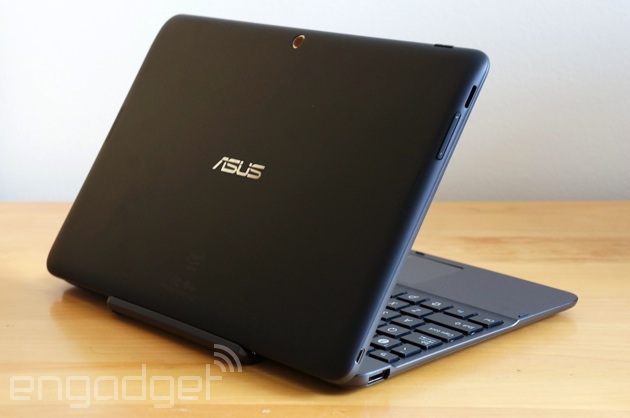 Spend enough time with the TF103C and it's patently obvious why it
only costs $299. ASUS has whittled the dockable tablet down to the
essentials, with just about every luxury tossed aside; you won't find a
breathtaking display, good cameras, long battery life or video output.
What's left, though, continues to be tempting. This is a brawny tablet
for the money, whether or not you use the netbook-like functionality all
that frequently. If you do, it might even be an ideal laptop
substitute. The Transformer Pad is more expensive than the cheapest Chromebooks, but it's slightly faster and carries an abundance of native apps.
Spend enough time with the TF103C and it's patently obvious why it
only costs $299. ASUS has whittled the dockable tablet down to the
essentials, with just about every luxury tossed aside; you won't find a
breathtaking display, good cameras, long battery life or video output.
What's left, though, continues to be tempting. This is a brawny tablet
for the money, whether or not you use the netbook-like functionality all
that frequently. If you do, it might even be an ideal laptop
substitute. The Transformer Pad is more expensive than the cheapest Chromebooks, but it's slightly faster and carries an abundance of native apps.
You do have to ask whether you need the keyboard at all, though, and that's the real dilemma -- many people don't. If you're no fan of the Transformer concept, the TF103C won't change your mind. The savings from passing on the keyboard can be rolled into a tablet that may not be as good at productivity, but could easily be superior for books, games and movies. Give the Transformer Pad a close look if you're at least mildly curious about the dock; just be sure to keep its competition in mind before you take the plunge.
edit
edit
Don't expect a revolution on the outside. Aside from the smooth matte finish on the non-removable back and some cosmetic tweaks to the speaker grilles, the TF103C will seem awfully familiar if you've used a Transformer-series tablet like the T100. Not that I'm grousing much about it. That still makes for a comfortable grip, and the tablet alone is light for its size at 1.2 pounds -- not as svelte as the 1.07-pound Galaxy Tab 4 10.1, but on par with LG's similarly sized G Pad. About the only step backward is the overly smudge-prone casing on the black model. You'll want to track down the white variant if you insist on keeping the case looking pristine.
Of course, that also means the same drawbacks have returned. The tablet's 16:10 aspect ratio is fine for landscape viewing -- arguably where you'll spend most of your time -- but not so hot for reading books in portrait mode. Moreover, the combination of dock and tablet is relatively thick (0.78 inch) and heavy (2.43 pounds) considering the energy-efficient technology you're getting. I'm not expecting something wafer-thin, but it would be nice if the TF103C were easier to tote around than far more powerful devices like the 11-inch MacBook Air or Surface Pro 3, you know?

You won't find a lot of future-proofing inside, either. The starter Transformer ships with ordinary 802.11n WiFi and Bluetooth 4.0 for wireless, and my test unit carries a modest 16GB of built-in storage. There's an 8GB version, too, but you're not likely to find it in the US. That's just as well, since you'd run out of space very quickly with that model; even my device had just 10.3GB free before I started piling on the apps. You will find built-in GPS and GLONASS positioning, though, so you won't need to splurge on a cellular-ready tablet just to navigate through an unfamiliar city.
Keyboard dock

Having said that, all the quirks from recent ASUS docks remain intact. The buttons are a bit noisy, and some of them (especially the arrows and function key) are too tiny to find by feel alone. It also took some time to get used to the inherently top-heavy nature of the docked combo. Mind you, that's partly due to what's missing in the dock this time around -- a secondary battery. While you won't find one in the higher-end TF303CL or many other dockable tablets, the absence is disappointing given that earlier Transformers often made use of a spare cell.
Display and sound

Audio is another story. The two rear-firing speakers are barely loud enough for a quiet environment, even if you cup your hands around the speakers to direct the sound forward. Bass is equally weak -- playing dance music will leave you without the satisfying punch you get on the G Pad 8.3 or recent iPads. While the output is clear, I just couldn't get engrossed in movie dialogue or music without plugging in some headphones. Should you want a mobile media center, you're better off giving up the TF103C's screen real estate to get something with a fuller sound and a sharper picture.
Software

ASUS doesn't go overboard with preloaded apps, for that matter. Most of what you'll see are lightweight utilities that fill in a few gaps in Android's stock interface, like Splendid (display calibration) and Do It Later (to-do lists). Some are deeper, if not always useful. I most appreciated SuperNote, which lets you jot down a mix of typed and drawn notes; Story, on the other hand, is the classic diary app that you try once and quickly forget. I found the third-party software more practical. You'll have Flipboard, Kindle and Zinio apps for reading, while eMusic gives you another means of downloading tunes beyond Google Play.
Performance and battery life
| ASUS Transformer Pad TF103C | ASUS Padfone X | Samsung Galaxy Tab S ** | Apple iPad Air *** | |
|---|---|---|---|---|
| Quadrant 2.0 | 18,921 | 22,032 | 18,591 | N/A |
| Vellamo 2.0 | 1,873 | 2,308 | 1,672 | N/A |
| SunSpider 1.0.2 (ms)* | 611 | 906 | 1,109 | 393 |
| 3DMark IS Unlimited | 14,171 | 19,523 | 12,431 | 15,328 |
| GFXBench 3.0 Manhattan Offscreen (fps) | 8.2 | 12 | 5.5 | 12.7 |
| CF-Bench | 22,586 | 32,937 | 31,695 | N/A |
|
*SunSpider: Lower scores are better. **Average scores for the 8.4- and 10.5-inch models. ***Not all of our Android benchmarks are cross-compatible with iOS. |
||||
That's borne out by the real-world performance. I've already touched on the zippy interface, but the Transformer Pad doesn't act like an econo-slab when running apps, either. Web pages pop up quickly, and even a graphics-heavy 3D game like Real Racing 3 runs smoothly regardless of what's on the screen. To some extent, the lower-resolution display helps keep things quick; there aren't as many pixels to push around, after all. Even so, it's apparent that this Transformer Pad has more muscle than you'd expect, and our offscreen graphics test (GFXBench) shows that it wouldn't be a slouch with a 1080p display.

Keeping the 11-hour battery life would have been nice, too. The Transformer Pad's 19-watt-hour lithium cell is officially rated for a less ambitious 9.5 hours when playing non-stop 720p video, and that's assuming you both keep the screen relatively dim (100 nits) and avoid social networks. In Engadget-grade stress testing, which upped the brightness to the halfway mark (200 nits) and allowed for updates from Facebook and Twitter, the tablet conked out after eight hours and 26 minutes. That's not terrible by any stretch, but it's a far cry from the 10-plus hours of the T100, the Galaxy Tab S and most iPads.
| Tablet | Battery Life |
|---|---|
| ASUS Transformer Pad TF103C | 8:26 |
| Microsoft Surface 2 | 14:22 |
| iPad Air | 13:45 (LTE) |
| Apple iPad mini | 12:43 (WiFi) |
| Samsung Galaxy Tab S (10-inch) | 12:30 |
| Samsung Galaxy Tab S (8-inch) | 12:22 |
| Apple iPad mini with Retina display | 11:55 (LTE) |
| Apple iPad (late 2012) | 11:08 (WiFi) |
| ASUS Transformer Book T100 | 10:40 |
| Apple iPad 2 | 10:26 |
| Samsung Galaxy Note Pro 12.2 | 10:04 |
| Apple iPad (2012) | 9:52 (HSPA) / 9:37 (LTE) |
| Acer Iconia W4 | 9:50 |
| Nexus 7 (2012) | 9:49 |
| Microsoft Surface RT | 9:36 |
| Toshiba Encore | 8:45 |
| Sony Xperia Tablet Z | 8:40 |
| Sony Xperia Z2 Tablet | 7:57 |
| Nexus 10 | 7:26 |
| Dell Venue 8 Pro | 7:19 |
| Samsung Galaxy Note 8.0 | 7:18 |
| Nexus 7 (2013) | 7:15 |
| Samsung Galaxy Tab Pro 8.4 | 7:13 |
| Samsung Galaxy Tab 3 10.1 | 6:55 |
Camera

You might have gathered that the TF103C wouldn't be a photography champ from the specs... and you'd be right. The 2-megapixel rear camera isn't the worst I've seen on a device -- that dubious honor belongs to the ZTE Open -- but it produces drab-looking photos and videos even in good lighting. Low detail, blown-out highlights and lots of noise are commonplace. In darker conditions, the results are downright ugly. Meanwhile, the front 0.3-megapixel camera is only properly useful for video conversations. It's slightly ironic that the shooting interface includes a full range of filters and settings (including ISO and white balance), since you're rarely, if ever, going to get a masterpiece. Really, the cameras are more utilitarian than anything. They're here to make sure you can capture a whiteboard or say hello on Skype, and not much else.
The competition

But what if you don't need a keyboard? That's where it gets complicated, and where ASUS has some reasons to be nervous. As mentioned earlier, Android fans have a lot of options around $300, and what you get depends on how much you crave a 10-inch display. Samsung's Galaxy Tab 4 10.1 doesn't fare well here. For $50 more, you're both ditching the keyboard and taking a performance hit; you'd have to be a huge fan of multi-window support or better cameras to splurge. LG's G Pad 10.1 delivers more value at $250, but it's still underpowered. And it may be smarter to forego some screen area if raw power is what you're after. LG's G Pad 8.3 now sells for the same $299 with a much nicer 1,920 x 1,200 LCD, a fairly nimble Snapdragon 600 processor and superior cameras. As I write this, you can also shell out $40 more for Amazon's 8.9-inch Kindle Fire HDX to get many of the G Pad's features in a bigger body, provided that you're okay with missing out on Google's app ecosystem.
I'd be remiss if I didn't touch on a couple of Windows alternatives, in case you aren't wedded to Android. HP's Omni 10 officially sells for $400, but it's easy to buy for much less -- you can pick one up for as little as $250 from Amazon. You'll lose the keyboard, but you'll get an extra-sharp screen along with heaps of additional storage and memory. ASUS loyalists, in turn, will want to consider the Transformer Book T100. It costs a reasonable $350 if you play your cards right, although you may end up buying through smaller stores (such as Newegg's affiliates) to score that kind of discount.
Wrap-up

You do have to ask whether you need the keyboard at all, though, and that's the real dilemma -- many people don't. If you're no fan of the Transformer concept, the TF103C won't change your mind. The savings from passing on the keyboard can be rolled into a tablet that may not be as good at productivity, but could easily be superior for books, games and movies. Give the Transformer Pad a close look if you're at least mildly curious about the dock; just be sure to keep its competition in mind before you take the plunge.
Full Specifications
8GB specs
- Tablet
- Android (KitKat [4.4])
- 10.1 inches
- Internal storage (8 GB, Flash),...
- 2 megapixels
- Up to 9.5 hours
- June 2, 2014
General
- Handheld
- Tablet
- Android (KitKat [4.4])
Input
- Yes
- Yes
Networking
- 802.11 a, b, g, n (2.4, 5 GHz)
- WEP, WPA, WPA2
Media
- Yes
Camera
- 2 megapixels
- Records video, Auto focus, Digital zoom, Contact pictures
- 0.3 megapixels
Sync
- OTA sync
Display
- 10.1 inches
- 1280 x 800
- LCD (Active, Color)
- Capacitive [finger]
Storage
- Internal storage (8 GB, Flash), Memory card
- microSD
Power
- Up to 9.5 hours
- Rechargeable
- Li-polymer
Audio
- 3.5mm
- Mono
Connections
- 2.0 (Micro-USB port, USB charging)
- 4.0
- HSP [headset], HFP [hands-free], A2DP [stereo audio], AVRCP [media control], DUN [network sharing], HID [peripherals]
Hardware
- Other
- Intel Atom Z3745 64-bit
- 1.86 GHz
- Quad-core
- 1 GB
Pricing & availability
- Available
- June 2, 2014
Colors
16GB specs
- Tablet
- Android (KitKat [4.4])
- 10.1 inches
- Internal storage (16 GB, Flash),...
- 2 megapixels
- Up to 9.5 hours
- June 2, 2014
General
- Handheld
- Tablet
- Android (KitKat [4.4])
Input
- Yes
- Yes
Networking
- 802.11 a, b, g, n (2.4, 5 GHz)
- WEP, WPA, WPA2
Media
- Yes
Camera
- 2 megapixels
- Records video, Auto focus, Digital zoom, Contact pictures
- 0.3 megapixels
Sync
- OTA sync
Display
- 10.1 inches
- 1280 x 800
- LCD (Active, Color)
- Capacitive [finger]
Storage
- Internal storage (16 GB, Flash), Memory card
- microSD
Power
- Up to 9.5 hours
- Rechargeable
- Li-polymer
Audio
- 3.5mm
- Mono
Connections
- 2.0 (Micro-USB port, USB charging)
- 4.0
- HSP [headset], HFP [hands-free], A2DP [stereo audio], AVRCP [media control], DUN [network sharing], HID [peripherals]
Hardware
- Other
- Intel Atom Z3745 64-bit
- 1.86 GHz
- Quad-core
- 1 GB
Pricing & availability
- Available
- June 2, 2014
Colors
-
UPC: 886227743322
Amazon ID (ASIN): B00JOI6FZ8
3G (TF103CG) specs
- Tablet
- Android (KitKat [4.4])
- 10.1 inches
- Internal storage (8 GB, Flash),...
- 2 megapixels
- July, 2014
General
- Handheld
- Tablet
- Android (KitKat [4.4])
Input
- Yes
- Yes
Networking
- Yes
- GSM-based
Media
- Yes
Camera
- 2 megapixels
- Records video, Auto focus, Digital zoom, Contact pictures
- 0.3 megapixels
Display
- 10.1 inches
- 1280 x 800
- LCD (Active, Color)
- Capacitive [finger]
Storage
- Internal storage (8 GB, Flash), Memory card
- microSD
Audio
- 3.5mm
- Mono
Hardware
- Other
- Intel Atom Z3745 64-bit
- 1.86 GHz
- Quad-core
- 1 GB
Pricing & availability
- Pre-release
- July, 2014
- June 2, 2014


No comments:
Post a Comment